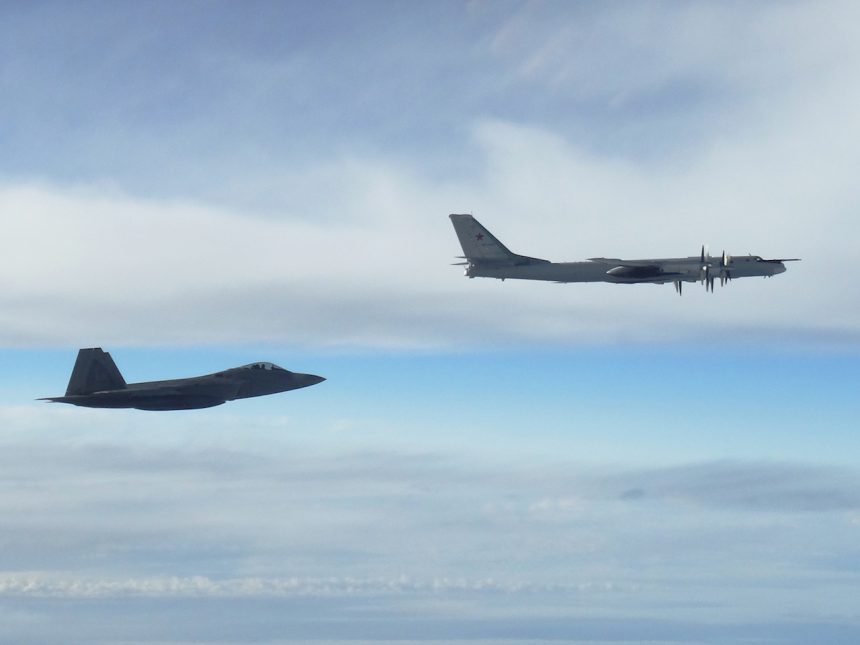This time the Bear bombers were escorted by Su-35 jets.
On Sept. 11, at approximately 10 PM EDT, two U.S. Air Force F-22 Raptor fighter jets “positively identified and intercepted two Russian Tu-95MS A“Bear-H” bombers west of Alaska.
Nothing special then, considered that a similar intercept had occurred on Sept. 1. However, this time the Russian bombers, flying in international airspace but inside the Alaskan ADIZ (Air Defense Identification Zone) – a special zone, that can extend well beyond a country’s territory where aircraft without authorization may be identified as a threat and treated as an enemy aircraft, leading to an interception and VID (Visual Identification) by fighter aircraft – were accompanied by two Russian Su-35 “Flanker” fighter jets.
F-22s are among the aircraft in QRA (Quick Reaction Alert) scrambled by NORAD in support of Operation Noble Eagle, launched in the aftermath of 9/11 to prevent a recurrence of Sept. 11, 2001-style air attacks in U.S. and Canada.
This is not the first time some Flanker jets operate alongside the Russian bombers on their long range sorties. Indeed, this is what this Author wrote commenting the previous intercept earlier this month:
Such close encounters are quite frequent and may also involve fighters, as happened in 2017, when the Bears were escorted by two Su-35S Flanker-E jets, and an A-50 AEW (Airborne Early Warning) aircraft. Anyway, this is the second time that Russian Bears pay a visit to the Alaskan ADIZ: on May 12, 2018, two F-22s were launched to perform a VID and escort two Tu-95 on a similar mission in the Northern Pacific.
In fact, in May 2017, a “mini-package” of two Russian nuclear-capable Tu-95MS Bear bombers escorted by two Su-35S Flanker-E jets and supported by an A-50 Mainstay flew inside the Alaskan ADIZ (Air Defense Identification Zone), and was intercepted by two U.S. Air Force F-22 Raptors some 50 NM to the south of Chariot, Alaska.
Here’s what we wrote back then:
The Su-35 is a 4++ generation aircraft characterized by supermaneuverability. Although it’s not stealth, it is equipped with a Irbis-E PESA (Passive Electronically-Scanned Array) and a long-range IRST – Infrared Search and Tracking – system capable, (according to Russian sources…) to detect stealth planes like the F-35 at a distance of over 90 kilometers.
[…]
In my opinion the “mini package” was launched as a consequence of the increased flight activity in Alaska related to the Northern Edge exercise, confirming that the Russians closely observe what happens in the Alaskan area.
This time, they wanted to showcase their ability to plan a complex long-range sortie as well as the Flanker’s readiness to escort its own HVA (high value asset), the Bear, during operations at strategic distance.
The composition of this package is also worth a comment.
The presence of the Mainstay should not be underestimated. It was flying well behind the Flanker and Bear aircraft with a specific purpose. As an AEW (Airborne Early Warning) platform the A-50 is believed to embed some ESM (Electronic Support Measures): in other words, it is able to detect far away targets as well as able to sniff radar, radio and data link emissions. Furthermore, Raptors in QRA (Quick Reaction Alert) *usually* fly with external fuel tanks and Luneburg lenses: this means that they are (consciously) visible to radars. In such conditions, although it can’t “characterize” the clean F-22’s signature, the Mainstay can at least gather some data about the interceptors’ radar emissions (if any) and observe and study their tactics.
Therefore, as frequently happens on both sides since the Cold War, on May 3, the Russians most probably carried out another simulated long-range strike mission but with a precise ELINT (ELectronics INTelligence) objective: the Flankers and Bears were acting as a “decoy” package to test the American scramble tactics and reaction times, whereas the Mainstay, in a back position, tried to collect as much signals and data as possible about the US fighters launched to intercept them.
General Terrence J. O’Shaughnessy, the NORAD Commander, commented the latest event in a public release as follows: “The homeland is no longer a sanctuary and the ability to deter and defeat threats to our citizens, vital infrastructure, and national institutions starts with successfully detecting, tracking, and positively identifying aircraft of interest approaching U.S. and Canadian airspace. NORAD employs a layered defense network of radars, satellites, as well as fighters to identify aircraft and determine the appropriate response.”
Top image credit: U.S. Air Force








